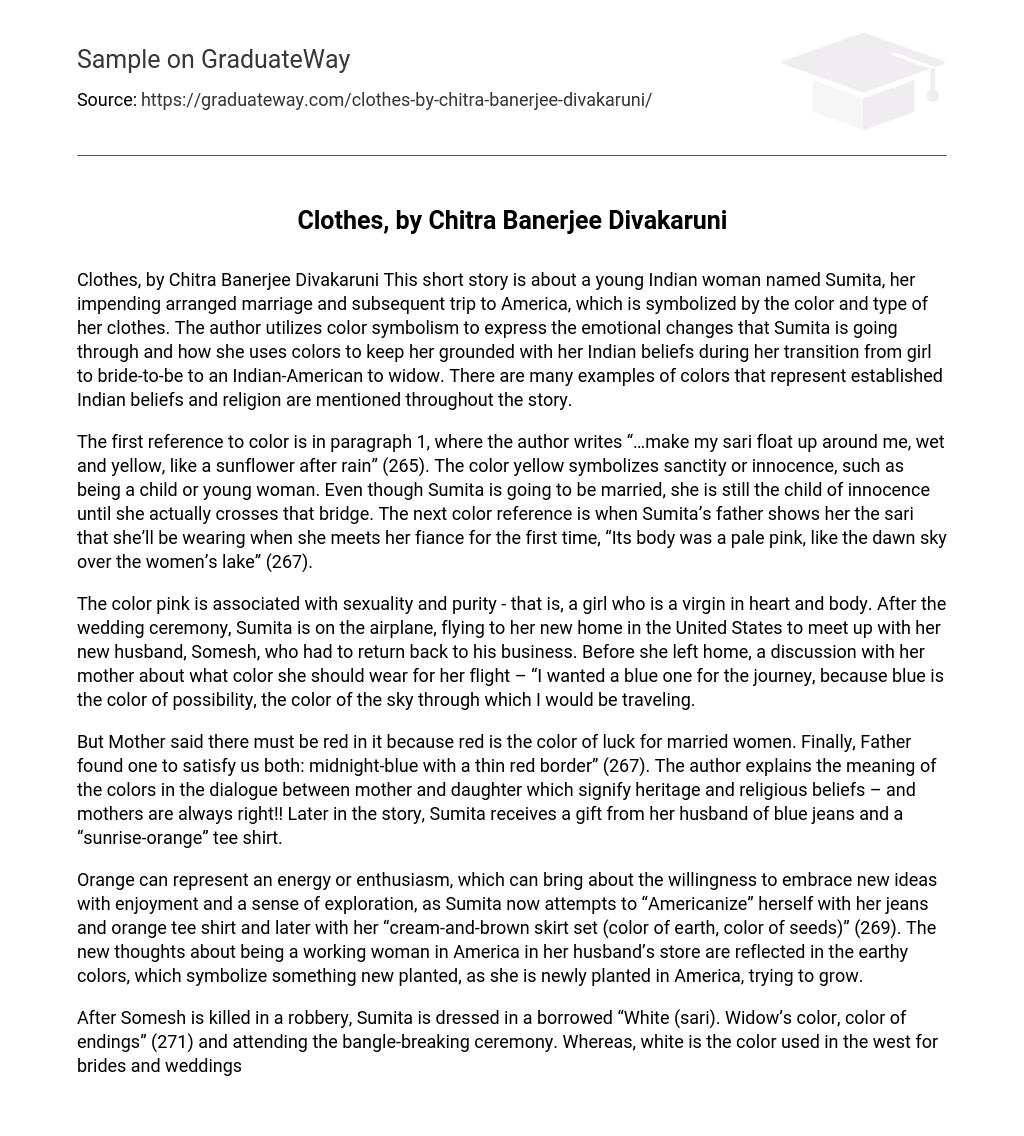Clothes short story is about a young Indian woman named Sumita, her impending arranged marriage and subsequent trip to America, which is symbolized by the color and type of her clothes. The author utilizes color symbolism to express the emotional changes that Sumita is going through and how she uses colors to keep her grounded with her Indian beliefs during her transition from girl to bride-to-be to an Indian-American to widow. There are many examples of colors that represent established Indian beliefs and religion are mentioned throughout the story.
The first reference to color is in paragraph 1, where the author writes “…make my sari float up around me, wet and yellow, like a sunflower after rain” (265). The color yellow symbolizes sanctity or innocence, such as being a child or young woman. Even though Sumita is going to be married, she is still the child of innocence until she actually crosses that bridge. The next color reference is when Sumita’s father shows her the sari that she’ll be wearing when she meets her fiance for the first time, “Its body was a pale pink, like the dawn sky over the women’s lake” (267).
The color pink is associated with sexuality and purity – that is, a girl who is a virgin in heart and body. After the wedding ceremony, Sumita is on the airplane, flying to her new home in the United States to meet up with her new husband, Somesh, who had to return back to his business. Before she left home, a discussion with her mother about what color she should wear for her flight – “I wanted a blue one for the journey, because blue is the color of possibility, the color of the sky through which I would be traveling.
But Mother said there must be red in it because red is the color of luck for married women. Finally, Father found one to satisfy us both: midnight-blue with a thin red border” (267). The author explains the meaning of the colors in the dialogue between mother and daughter which signify heritage and religious beliefs – and mothers are always right!! Later in the story, Sumita receives a gift from her husband of blue jeans and a “sunrise-orange” tee shirt.
Orange can represent an energy or enthusiasm, which can bring about the willingness to embrace new ideas with enjoyment and a sense of exploration, as Sumita now attempts to “Americanize” herself with her jeans and orange tee shirt and later with her “cream-and-brown skirt set (color of earth, color of seeds)” (269). The new thoughts about being a working woman in America in her husband’s store are reflected in the earthy colors, which symbolize something new planted, as she is newly planted in America, trying to grow.
After Somesh is killed in a robbery, Sumita is dressed in a borrowed “White (sari). Widow’s color, color of endings” (271) and attending the bangle-breaking ceremony. Whereas, white is the color used in the west for brides and weddings signifying purity, white is the color of mourning and death in the east. The green or red bangle, which in the Hindu religion symbolizes safety and a happy, prosperous and long married life, is required to be worn by married women.
As part of the mourning ceremony, the glass bangles are smashed, “so that the glass bangles I was wearing shattered and multicolored shards flew out in every direction (271). Color and color combinations are very important to many cultures and have been for centuries, reflecting their specific beliefs and meanings. Divakaruni used colors of clothing to signify and compare monumental events in the life of Sumita with the meaning of the color represented as it is in the Hindu religion.





